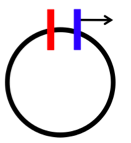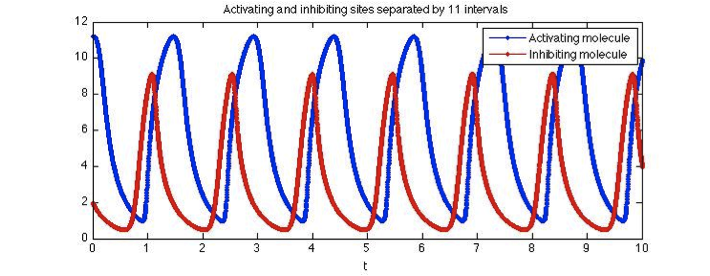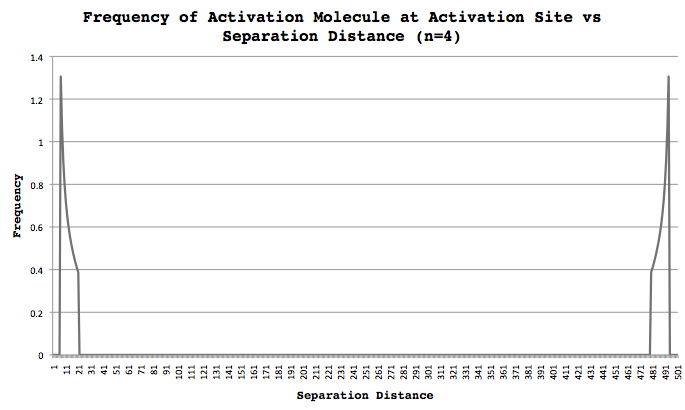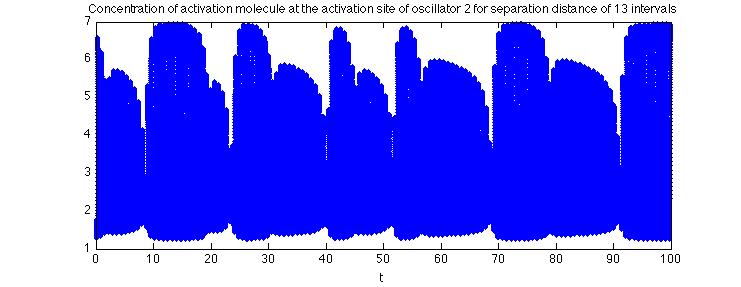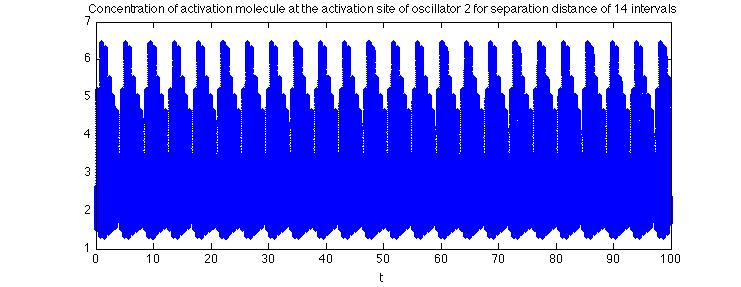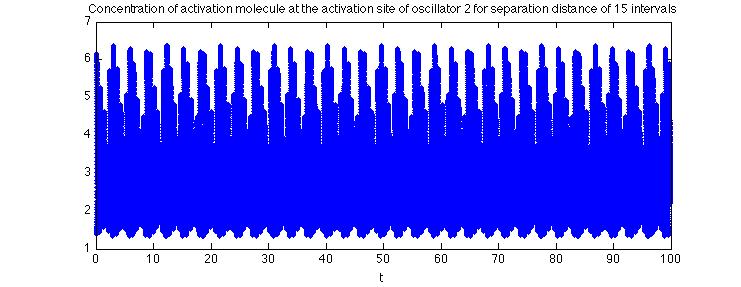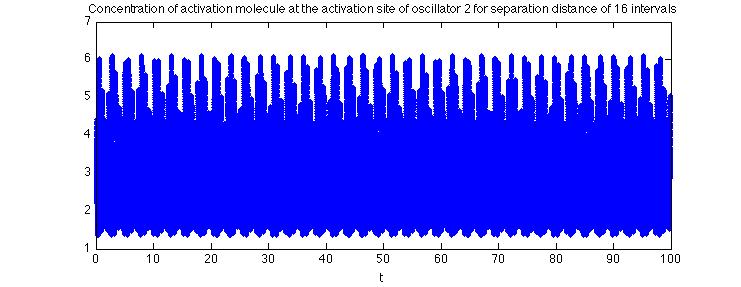Team:McGill/Modeling
From 2009.igem.org
(→One Oscillator) |
(→One Oscillator) |
||
| Line 86: | Line 86: | ||
A concern we have is that it is unlikely the parameters we have chosen are representative of the synthetic genetic network we are constructing in parallel. The major parameter that we currently have no control over whatsoever is the Hill coefficient n. We believe that if the Hill function is steep enough then the circuit will act as an on/off switch and oscillations are possible. Increasing n will only increase the steepness of the Hill function so we are safe in assuming that n > 8 will still lead to oscillations. However what is the smallest n that would still allow oscillatory behaviour? We calculated frequency for the range of separation distances with the following Hill coefficients n=2,3 and 4. | A concern we have is that it is unlikely the parameters we have chosen are representative of the synthetic genetic network we are constructing in parallel. The major parameter that we currently have no control over whatsoever is the Hill coefficient n. We believe that if the Hill function is steep enough then the circuit will act as an on/off switch and oscillations are possible. Increasing n will only increase the steepness of the Hill function so we are safe in assuming that n > 8 will still lead to oscillations. However what is the smallest n that would still allow oscillatory behaviour? We calculated frequency for the range of separation distances with the following Hill coefficients n=2,3 and 4. | ||
| - | [[Image: Mcgill09OneOscFreq_vs_Distance_n4.png|frame|center|Figure | + | [[Image: Mcgill09OneOscFreq_vs_Distance_n4.png|frame|center|Figure 6 - Frequency of Activation Molecule at Activation Site vs Separation Distance (n=4)]] |
| + | [[Image: Mcgill09OneOscFreq_vs_Distance_n4.png|frame|center|Figure 7 - Frequency of Activation Molecule at Activation Site vs Separation Distance (n=3)]] | ||
=='''Two Oscillators'''== | =='''Two Oscillators'''== | ||
Revision as of 20:38, 21 October 2009

Contents |
Introduction
Many models examining intercellular signaling do not take into account the separation distances of the signaling bodies. We use a partial differential equation (PDE) based model to gain insight into spatially heterogeneous activation-inhibition intercellular signaling.
Two types of signaling molecules exist: activating and inhibiting. Each molecule is synthesized by a unique strain of cells and affects the synthesis rate of the other strain.
This is modeled using the following system of PDEs:
where Ψ1 and Ψ2 represent the concentrations of the activating and inhibiting molecules, respectively, γi the degradation constant, Di the diffusion constant, λi the maximal synthesis rate of molecule i, and δ the Dirac function. fi represents the Hill function describing the dependence on the opposing molecule:
where n, b, and θ are positive. To simplify the analysis, we chose equal parameters between the activating and inhibiting sites (Appendix A).
Numerical Simulation
The above system was solved numerically using a forward Euler scheme in time and a centered difference scheme in space. Cyclical boundary conditions were assumed; meaning the spatial dimension formed a ring. This was chosen since simulating an approximate infinite line is computationally costly. However, this also allowed us to investigate two site geometries during one simulation (explained later). The ring was given a physical length of 50 and discretized into 500 intervals. For simplicity, separation distances will be reported in terms of numerical intervals rather than physical distance.
One Oscillator
We first explored the different potential dynamics when the separation distance between an activating and inhibitory site was increased.
The following is an example of the dynamics observed when the two sites are at a distance where oscillations occur.
By analyzing curves similar to those in figure 3 the frequency of oscillations was calculated. Figure 4 illustrates the sudden appearance of high frequency oscillations when the sites are near each other and the decreasing frequency as they are moved apart until oscillations disappear.

The observation that the steady state becomes unstable for a range of separations has been reported previously by Shymko and Glass (1974).
Another way of looking at how oscillations depend on separation distance is by plotting the value of a curve whenever its derivative is zero vs the separation distance. This will also tell us some information on how the shape of the oscillations change with separation distance.
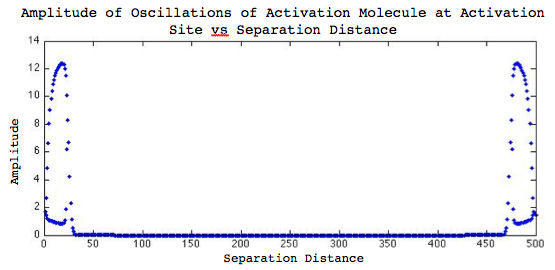
Notice the range of distances that have two values plotted correspond to the range of distances that have a nonzero frequency in figure 4.
A concern we have is that it is unlikely the parameters we have chosen are representative of the synthetic genetic network we are constructing in parallel. The major parameter that we currently have no control over whatsoever is the Hill coefficient n. We believe that if the Hill function is steep enough then the circuit will act as an on/off switch and oscillations are possible. Increasing n will only increase the steepness of the Hill function so we are safe in assuming that n > 8 will still lead to oscillations. However what is the smallest n that would still allow oscillatory behaviour? We calculated frequency for the range of separation distances with the following Hill coefficients n=2,3 and 4.
Two Oscillators
We next looked at a system consisting of two oscillators, where each consists of an activation and inhibitory site.
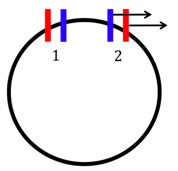
The distance between the two oscillators was varied while the distance between two sites within an oscillator was held fixed at 5 intervals. This value was chosen for demonstration purposes, however the dynamics to be described have been observed at various separation distances.
We first look at the change in frequency as the oscillators are moved apart.
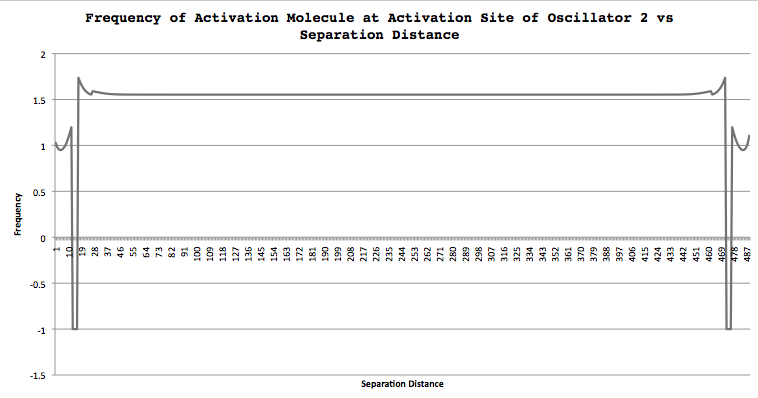
The first striking feature of this graph is the appearance of separation distances that have negative frequencies. The value of -1 is assigned to a separation distance that results in a complex oscillation whose frequency cannot be resolved using a simple method, which assumes simple periodic motion. Before we look into these curves, let's look over the entire graph. When the two oscillators are very close together, their frequency is always less than an isolated oscillator (look at figure 4 for two sites with a separation distance of 5 intervals). Interestingly, between the separation distances of 1 and 10 there appears to be a local minimum frequency. Meaning as the oscillators are moved apart, their frequency initially decreases and then begins increasing. This trend of increasing frequency continues until the numerical method calculating frequency breaks down. The following figure illustrates the concentration of the activation molecule at the activation site of oscillator 2 for the first distance that results in an oscillation whose frequency cannot be computed.
It is immediately obvious why the frequency measuring numerical method failed, the oscillations are far from simple. Before investigating this curve further, let's take a look at the other separation distances that resulted in complex oscillations.
The separation distances 474,475,476, and 477 resulted in similar dynamics and are not shown for brevity.
We first wanted to know whether these were truly the only separation distances that resulted in this type of dynamics. We recalculated the frequency of oscillations at each separation distance after simulating for 10,000 time units. In this way we hoped to overcome any transient dynamics and observe the true interaction. This resulted in the same set of separation distances having complex oscillations while everywhere else had regular simple oscillations. Furthermore, we recalculated the frequency of oscillations at each separation distance by using the final time point of the immediately preceding separation distance as the initial condition. We thought this would allow a quicker convergence to the stable limit cycle. However this also resulted in the same findings as before.
Appendix A - Parameters
The standard set of parameters used to observe oscillations were taken directly from Shymko and Glass (1974).
γ = 2, D = 2, λ = 54, θ = 1, b = 0, N = 8.
Both strains were assumed to have identical parameters in order to simplify the model as well as explicitly observe the dependence of dynamics on separation distance.
 "
"



